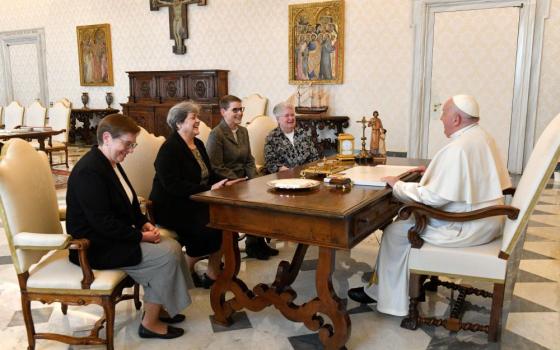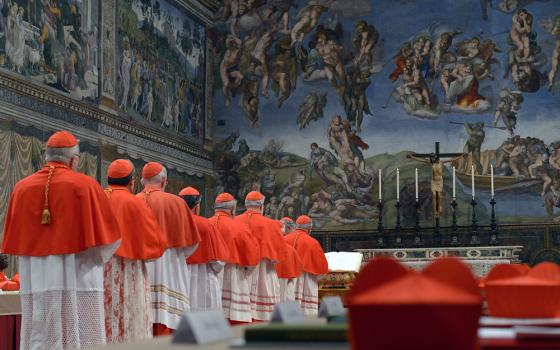HOLY MISOGYNY: WHY THE SEX AND GENDER CONFLICTS IN THE EARLY CHURCH STILL MATTER
By April D. DeConick
Published by Continuum, $24.95
In both our churches and our political arena, women’s issues appear to be as contentious and controversial as ever. Whether it is the Vatican’s extreme ban on the ordination of women and the receivership of the Leadership Conference of Women Religious or the ongoing political fights over the government’s provision of contraception and equal pay, those braving these battles may find sustenance in a crop of new books that explore the relationships between women, God and the church.
April DeConick’s Holy Misogyny is the product of 25 years of reflection and study of the Bible’s relationship to understandings of sex and gender in the ancient Mediterranean world. DeConick, a professor of biblical studies at Rice University in Houston, was inspired to write the book when her young son asked her, “Where is Lady God?”
“Here was my 5-year-old child giving voice to what has been for hundreds of years the prickly thorn of Christian theology and ecclesiology,” DeConick writes. That is, the absence of a feminine image of God. DeConick mines deeply into ancient Jewish and Christian history as well as the texts of the New Testament to answer questions that are crucial to a fuller understanding of the status of women, not only in the Roman Catholic church, but in any society with Judeo-Christian roots. Each chapter asks an intriguing question of the tradition. Why was the Holy Spirit neutered? Did Jesus think sex was a sin? Did Paul silence women?
Readers will gain insights into why male imagery for God remains dominant, why women are associated with sin, and why the notion of women priests still arouses so much negative sentiment. Many will be satisfied with DeConick’s conclusion that the distortion and erasure of the female in Christian history “is the result of ancient misogyny made divine writ.”
Though DeConick is a scholar and this book the fruit of her scholarship, her writing is remarkably accessible for lay audiences, and even quite humorous. Holy Misogyny is an invaluable resource for those looking to find the historical roots of the ongoing struggle for women’s equality in the Christian tradition.
 FEMINIST MYSTICISM AND IMAGES OF GOD: A PRACTICAL THEOLOGY
FEMINIST MYSTICISM AND IMAGES OF GOD: A PRACTICAL THEOLOGY
By Jennie S. Knight
Published by Chalice Press, $24.99
If DeConick’s text traces the roots of holy misogyny, Jennie S. Knight’s Feminist Mysticism and Images of God presents a thorough picture of its repercussions. Knight presents her study of the importance of feminine images of the divine for expanding faith and spirituality, developing a holistic self-image, and deepening the intimacy of one’s relationship with God.
Knight, who serves as assistant professor in the practices of religious education and community ministries and director of religious education at the Candler School of Theology at Emory University in Atlanta, finds a disconnect between the seminary and church communities. Though many seminary students learn about the importance of using feminine images for the divine, they are apprehensive about introducing these images of God once they begin ministry in their congregation. “Little has changed in the context of worship, even in seemingly progressive churches and denominations,” she writes.
 The crux of Knight’s book comes in her study of women from the Atlanta-based community Mary and Martha’s Place, an “extrachurch nonprofit center devoted to women’s spirituality and feminist theological study.” Woven throughout the book are interviews with four women from the center. Readers may be able to relate to these members, whom Knight describes as women “on a spiritual quest” who are “not nurtured by the traditional parish setting.”
The crux of Knight’s book comes in her study of women from the Atlanta-based community Mary and Martha’s Place, an “extrachurch nonprofit center devoted to women’s spirituality and feminist theological study.” Woven throughout the book are interviews with four women from the center. Readers may be able to relate to these members, whom Knight describes as women “on a spiritual quest” who are “not nurtured by the traditional parish setting.”
Knight includes these personal narratives because, though there is bountiful literature on reimaging the divine from feminist, womanist, mujerista and black perspectives, little attention has been paid to the “lived experience of individuals as they interact with particular images in their cultural contexts.”
Knight believes that Christianity is in a state of crisis in terms of the deepening needs of women and, by extension, men. The goal of Knight’s book resonates deeply with those who are hurt by the Vatican’s crackdown on LCWR. She writes, “I hope that church leaders and scholars alike will pay attention to communities such as [Mary and Martha’s Place] as being examples of a passion and need for spiritual growth in our culture, rather than as aberrant extrachurch organizations.”
Though Knight’s approach to this topic is scholarly and at times heavy with academic ideas and references, her interviews with the four women subjects do a fine job of exemplifying the book’s many insights. Feminist Mysticism and Images of God is essential reading for those interested in the impact that imagery for God has on the vitality and future of church communities.
 MOTHERS, SISTERS, DAUGHTERS: STANDING ON THEIR SHOULDERS
MOTHERS, SISTERS, DAUGHTERS: STANDING ON THEIR SHOULDERS
By Edwina Gateley and Sandra Mattucci
Published by Orbis Books, $20
In Mothers, Sisters, Daughters: Standing on Their Shoulders, Edwina Gateley and Sandra Mattucci celebrate the lives of 22 women who have “brought some light into the world.” Each woman is introduced through a brief biography and an extended free verse poem.
While the authors do not make it clear who serves as the biographer and who is the poet, followers of Gateley’s recordings and books will recognize her voice in the poetry. The verses help to flesh out each of these great figures, and put us in deeper touch with their passions, fears and longings.
The selection of women is marvelous: intergenerational, racially and ethnically diverse, and deeply ecumenical. Gateley and Mattucci draw from great figures of the Bible and history as well as from contemporary justice-seekers, mystics and environmentalists. Readers will enjoy revisiting the lives of towering icons like Hildegard of Bingen and Mother Teresa, and will be introduced to 21st-century prophets like Notre Dame de Namur Sr. Dorothy Stang and Wangari Muta Maathai. It is also a pleasant surprise to find Emily Dickinson and Rachel Carson in the mix.
Mothers, Sisters, Daughters is an easy read, but the examples set by the women profiled will challenge readers to the very core of their beings. Gateley and Mattucci have made a great contribution to widening our understanding of the communion of saints. It is an excellent resource for retreat facilitators and would make a wonderful confirmation or graduation gift.
Though the authors explore the topics of women, God and the church from very different angles, each text makes an important contribution to our understanding of the ways in which the spirit of God has moved through women in history. DeConick seeks to reinscribe the memory and gifts of women into Christianity antiquity, Knight demonstrates the transformative power of feminine images of God, and Gateley and Mattucci lift up female spiritual heroes with deep connections to the divine.
Though each author has her own approach, they share a common hope that women will cease to be understood as a threat to the Christian tradition and, instead, will be honored for their ongoing role in enlivening it.
[Jamie L. Manson received her master of divinity degree from Yale Divinity School, where she studied Catholic theology and sexual ethics. Her Web column, Grace on the Margins, appears Mondays on the NCR website at NCRonline.org/blogs/grace-on-the-margins.]



